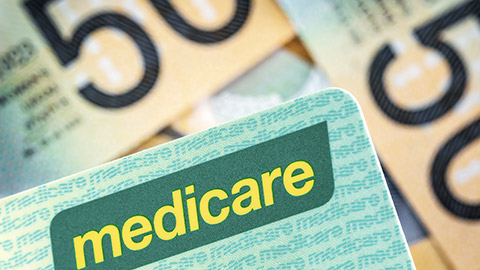In this section you will learn to:
- Receive and document payments
- Prepare and issue receipts to person or authority
- Reconcile Medicare payments with claims made
- Follow up on overdue accounts
- Provide and store financial information
Supplementary materials relevant to this section:
Reading E: Follow Up on Unpaid Invoices
In this section of the module, we will look at how you could process accounts. Specifically, we will look at how to receive and document payments made by patients, Medicare, and other relevant organisations. We will then look at the process of reconciling Medicare payments and how to follow up on overdue accounts. Keep in mind that the procedures here are only general guidelines, and you should adhere to the relevant policy and procedures set out by your workplace, along with any relevant legislative requirements in your jurisdiction. We will also briefly look at how to provide and store patient’s financial information
In the previous sections of this Study Guide, you learned about the different account types: bulk billing, private patients, health insurance providers, and more. Depending on the services provided by your workplace and the fee structure, you may receive payments from different parties. We will briefly look at these.
Medicare
The most common source of payment would be from Medicare, especially if your workplace bulk bills patients. According to Services Australia (n.d.), Medicare only pays bulk bill payment by electronic fund transfer (EFT) towards the registered bank account details. The payment time will depend on a few different factors, such as the claims channel used, billing agents, and involvement of private health funds, but generally ranges from 24 hours from the date of lodgement to three working days.
Private Patients
As mentioned in earlier sections in this Study Guide, there are a few different options to private bill patients. Depending on your workplace, the receipt of payment will be different as well. For example, if your workplace chooses to settle the account with the patient, you will not receive any payment from Medicare. On the other hand, if your workplace’s procedure is to charge patients the gap fee, i.e., out-of-pocket cost, you will receive the Medicare payment after lodging the claim. Therefore, it is important you clarify and familiarise yourself with your workplace’s procedure, so you can have a good idea when you can expect the payment to be made to your workplace and reconcile the account.
Other Claims
Similar to bulk bill accounts, DVA claims are made via EFT towards the registered bank account details in the DVA system. Note that DVA claims must be submitted by your workplace or a delegate, and not by the patient.
Other types of claims such as private health insurance providers will have different claim processing time, which you should familiarise yourself with to anticipate when you will be receiving payments from different organisations. If you have any questions or are confused, you should clarify with your supervisor or practice manager.
Of course, the process you need to know will depend on the services your workplace provides. For example, if you work in a cosmetic surgery clinic, you would most likely not be tasked with making Medicare payments, as Medicare does not cover cosmetic surgery.

After receiving payments, you would need to document the payments received. This is typically done by issuing receipts as proof of payment as well as documenting it in your workplace’s billing system. The information included in the receipt should be similar to the receipts issued to private patients. For example, the patient's name, payment date and amount, payment method, and services rendered. Your workplace would have their own receipt template that includes the required information which you have to fill in accordingly.
It is vital that payments received are documented properly to ensure keep track of the workplace’s financial records as well as to ensure transparency in the workplace’s accounts. Not only that, this is to make sure that payments are documented in a way that is compliant with the relevant legislative requirements, especially when audits are requested.
Other than documentation purposes, it was also mentioned earlier that you issue an accurate and proper itemised receipt to patients after they have made the payment. This is to assist them with lodging claims with either Medicare and/or other health insurance providers.
When documenting payments received, you need to make sure that the privacy of the patient is protected. Under the Privacy Act 1988 (Cth) and relevant state and territory legislation, you are obligated to ensure that the patient’s health information is kept private and confidential. Recall that a proper receipt will note the services provided to the patient, and this may contain the patient’s sensitive health information. Therefore, you need to adhere to your workplace’s policy and procedures regarding protecting the patient’s privacy such as ensuring only authorised staff have access to the workplace’s billing system.
If electronic receipts are issued, you also need to ensure that the electronic transactions are done in a safe and secured manner, such that the information cannot be intercepted or altered by a third party. Again, the specific requirements will depend on the services your workplace provides as well as the jurisdiction your workplace is located in. During your training or induction, you need to clarify with your supervisor about this and make sure you adhere to the requirements.

As you should know by now, it is crucial to maintain your workplace’s accounts properly by making sure all payments received are reflected accurately in the billing system. After receiving payments from Medicare, you can retrieve the payment statement or remittance advice from Medicare Easyclaim (or the claims channel that your workplace uses). Compare the information in the payment statement with the claims you lodged and check whether they match up. This can include information other than the payment amount, such as patient information, service fates, claim numbers, etc. If there are any discrepancies, you should note it down and flag it for further action. Remember, it is important that any actions taken are documented for transparency purposes, especially if there are any disputes that may arise from this.
For example, the payment made by Medicare may be in excess and you would need to document the excess amount and flag it for further action. Depending on your workplace’s policy and procedure and your specific role, you may need your supervisor or practice manager’s authorisation to to take further action such as contacting Medicare to review and resolve the payment discrepancy. This usually involves lodging for adjustment claims and you will need to update the billing system accordingly to reflect this change, and document any relevant actions.
Note that some practice management softwares are able to integrate with Medicare Easyclaim for automatic reconciliation (Services Australia, 2022). This can make your workflow much more efficient without having to manually reconcile each account. However, you should check with your workplace whether the accounts system used has this feature available, and if so, whether any additional procedures are put in place to review the reconciliation to avoid any error.
Watch

Some health service providers require patients to pay a deposit to secure their appointment while other service providers only charge clients after the service is rendered. Depending on your workplace, you may need to follow up on some accounts, including accounts that are past the payment due date. You need to adhere to your workplace’s procedures and clarify the frequency to follow up on accounts, e.g., some workplaces require daily review of accounts while others conduct weekly reviews. Regardless of the frequency, the general process would be similar, which we will look at now.
Once you identify an overdue account, you need to first review and gather account information such as the patient's name, account balance (outstanding payment amount), and the payment due date. Once you have gathered the required information, contact the patient to remind them about the overdue payment through the client’s preferred communication channels, e.g., emails, phone calls, or text messages. You should clarify with the patient about the overdue amount and any late payment penalties or charges, if applicable. For example, “Hi Freya, thank you for attending Get Healthy Practice three weeks ago and hope you’ve been well! I’m calling regarding the outstanding payment of $50.30 due a week ago. Along with a late payment interest of 1.5%, the outstanding amount comes to a total of $51.05. Please note that this amount is due by the end of the week and a weekly late interest fee of 1.5% will incur. Would you like to make the payment now?” It is important that your tone remains polite and professional when contacting the patient about their overdue accounts.
After explaining the outstanding amount, you may wish to clarify with the patient the reason behind the late payment. It may be possible that the patient is experiencing financial difficulties or delays in insurance claims, and thus unable to settle the account in a timely manner. You can discuss with the patient to come up with an agreed solution with the patient to settle the account. For example, any late interest charges will be waived or the overdue amount can be paid over a payment plan. However, this will depend on your workplace’s policy and procedures, as you may need your supervisor’s approval. Clarify this with your supervisor prior to making an agreement with the patient.
It is not unusual that the initial contact with the patient does not result in a payment, and may need follow up. Depending on the agreed solution, you could send regular reminders to the patients to remind them about the outstanding amount and the payment due date. It is important that you document all communications with the patient, including any proposed solution and follow-up actions taken. Other than to prevent any future dispute, it could also be helpful for other staff within your team when they are following up with the patient.
In some cases, a resolution could not be reached with the patient or the patient is uncontactable despite multiple attempts. Depending on your workplace, a medical debt collector may be engaged to help with collecting payment. This should also be communicated to the patient and have the communication attempted documented.
Read
Reading E – Following Up on Unpaid Invoices
Reading E provides an overview of how to communicate with patients regarding unpaid invoice using the Halaxy practice management software. This reading will be relevant to the assessment questions in your Assessment.

As mentioned, it is important that patient records, especially information and data about their accounts are handled in a confidential and safe manner. Your workplace should have its own policy and procedure regarding handling patient’s financial records and data. It is vital that you adhere to your workplace’s requirements, as well as any legislative requirements in your state or territory.
One of the important requirements that you should keep in mind is that no unauthorised personnel have access to this information. This includes health professionals who are not authorised to access a patient’s information. If a health professional (from your workplace or other service provider) requests for a patient’s records, you need to confirm the patient has provided their informed consent to do so. Otherwise, clarify with the patient before releasing the requested information. This is also in line with the Privacy Act 1988 to ensure that patient’s records and data are kept confidential.
Another thing to keep in mind when providing patient information is that you should do so in a secured and safe manner. If a physical copy needs to be mailed, make sure that it is transported in a sealed envelope. If an electronic copy is involved, ensure that the transfer is done using a secured connection and no unauthorised third party could intercept it.
Storing Financial Information
You need to ensure patients’ financial records and data are stored in accordance with your workplace’s policy and procedures about record management. For instance, the patients’ records are stored in a secured location such as a locked room and only authorised staff has access to it. You may also need to be mindful that these records are not left unattended at the reception area such that other patients may be able to access it. If the records are stored electronically, make sure that the data is backed up properly and the computer is password protected and only the relevant staff has the password. You should also never leave an unlocked computer unattended, as unauthorised individuals may access it and compromise the patient’s privacy.
Other than the patient’s privacy, it is important you follow your workplace’s record management procedure to ensure an efficient workflow. For example, you are required to store the files that contain the patient’s financial record according to their last name so their files can be retrieved easily by other authorised staff. Another protocol that your workplace may put in place is maintaining a log to record any instances of accessing patients’ financial records. This can help with accounting for any dispute or integrity issues, if any arise. You may be tasked with reviewing the log periodically to ensure there are no incidents of unauthorised access.
As part of your workplace’s record management policy, there should be guidelines around record retention, including how long a patient record should be retained. According to the Health Records and Information Privacy Act 2002 (Cth), health service providers must retain a patient’s information for seven years from the last occasion when a health service was rendered (Information and Privacy Commission NSW, 2022). While your workplace may opt to retain patient records for longer than seven years, it is still good for you to remember that seven years is the minimum retention period. You should also clarify with your supervisor regarding your workplace’s record retention policy to prevent any displacements of a patient’s information.
In this section of the module, you learned about processing accounts and storing financial records and data. Specifically, you first learned how to receive and document payments from Medicare and how to reconcile the payments received. After that, we also looked at how to follow up on accounts that are past their payment due date, including potential solutions such as payment plan and waiving interest charges. Lastly, we looked at how to provide and store patient’s financial information in a safe and secured manner to ensure the patient’s privacy is protected.
Information and Privacy Commission NSW. (2022, November). Fact sheet: A guide to retention and storage of health information in NSW for private health service providers. https://www.ipc.nsw.gov.au/sites/default/files/2022-11/Fact_Sheet_A_guide_to_retention_and_storage_of_health_information_in_NSW_for_private_health_service_providers_November_2022.pdf
Powerdiary. (n.d.). [Image of a cartoon woman holding an eftpos machine with a receipt and a notebook]. https://www.powerdiary.com/blog/medicare-billing-guidelines-physical-therapy-aus/
Services Australia. (n.d.). Medicare Benefits Schedule (MBS). https://hpe.servicesaustralia.gov.au/medicare-benefits-schedule.html
Services Australia. (2022, March 3). Reconciling Medicare Easyclaim payments.
